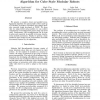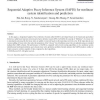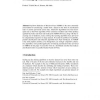1126 search results - page 20 / 226 » Modularity and the Rule of Adaptation |
DATAMINE
2008
13 years 8 months ago
2008
Rules are commonly used for classification because they are modular, intelligible and easy to learn. Existing work in classification rule learning assumes the goal is to produce ca...
ICRA
2002
IEEE
14 years 1 months ago
2002
IEEE
We present a complete, local, and parallel reconfiguration algorithm for metamorphic robots made up of Telecubes, six degree of freedom cube shaped modules currently being develop...
OHS
2001
Springer
14 years 27 days ago
2001
Springer
This paper introduces an adaptive hypermedia system that provides a means for information providers to direct their users through hyperspace. With our system, the information prov...
FSS
2006
13 years 8 months ago
2006
In this paper, a Sequential Adaptive Fuzzy Inference System called SAFIS is developed based on the functional equivalence between a radial basis function network and a fuzzy infer...
IFIP12
2008
13 years 10 months ago
2008
Top Down Induction of Decision Trees (TDIDT) is the most commonly used method of constructing a model from a dataset in the form of classification rules to classify previously unse...



